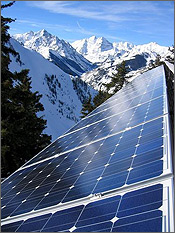Solar panels in winter: Is snow a problem?
It's that time of the year. The days are getting shorter and colder, and depending on where you live, you may have seen a snowflake or two. So what does winter mean for your solar panels or for your decision about whether it makes sense to even consider panels at this time of the year?
 Many people might be assuming that it's the extreme cold that would have a negative impact on the performance of the panels. In fact, the reverse is true. Solar photovoltaic panels operate more efficiently when they are not being heated up by the hot summer sun. What is more relevant is the fact that in winter, the days are not as long and the sun is lower in the sky, meaning that your panels will not receive as much irradiance as they would in the height of summer. But this doesn't mean that your panels won't still generate electricity in winter. As long as they are not covered in snow, your panels will still be making/saving you money. Let's compare some numbers.
Many people might be assuming that it's the extreme cold that would have a negative impact on the performance of the panels. In fact, the reverse is true. Solar photovoltaic panels operate more efficiently when they are not being heated up by the hot summer sun. What is more relevant is the fact that in winter, the days are not as long and the sun is lower in the sky, meaning that your panels will not receive as much irradiance as they would in the height of summer. But this doesn't mean that your panels won't still generate electricity in winter. As long as they are not covered in snow, your panels will still be making/saving you money. Let's compare some numbers.Solar panel output in winter compared to summer?
In Jersey City, New Jersey the Solar Score is 48. The average solar irradiance for the month of June is on the order of 5750 W/m2, compared to 1870 W/m2 for January. That means for a 5 kW system, the average-sized residential system, with the panels installed at an inclination of 30 degrees (where 0 degrees is horizontal and 90 degrees is vertical) your panels would produce approximately 760 kWh for the month of June compared to 425 kWh for January. The steeper your panels are in winter, the more energy you will produce because the sun is so low in the sky. In Toronto, Ontario the Solar Score is 42. The average solar irradiance for the month of June is on the order of 5800 W/m2, compared to 1420 W/m2 for January. That means those same panels would produce approximately 780 kWh for the month of June compared to 325 kWh for January.
The reason the irradiance value is so much greater in summer, compared to winter, is because it is a measure of the amount of sunlight reaching a flat plane. In other words, it is assuming that your panels are installed at an inclination of 0 degrees. But solar panels are not installed with a zero degree inclination. Determining the inclination becomes a question of optimizing the output of the panels with respect to the angle of the sun in all seasons, and with respect to the design of the panels and their installation method. Installers take into account a number of factors, such as the impact of snow and wind. The steeper the panels, the less snow will accumulate, as it will be able to slide off and not impinge on the electricity production. But too steep, and the panels could be damaged by wind.
So what about snow on your solar panels?
Should you be concerned about accumulation on your panels? If your panels are easily accessible, and you take the necessary precautions, you could consider cleaning off any build-up of snow, but as most panels are installed on a roof, and snow makes for slippery, dangerous conditions, it is not advisable to remove snow from most panels. Let nature takes its course and the snow will eventually melt or slide off, since the panels are smooth and the warmth they give off helps the snow slide. And if it is a longer-lasting problem, consider speaking with your installer about adjusting the angle before next winter, so that less of the white stuff dampens your output.
In conclusion, solar panels in northern climates do make sense. Don't let winter get you down. In fact, the colder it is, the sunnier it tends to be. So let the sun shine down on those panels and enjoy the savings!
Image credit: nrel.gov